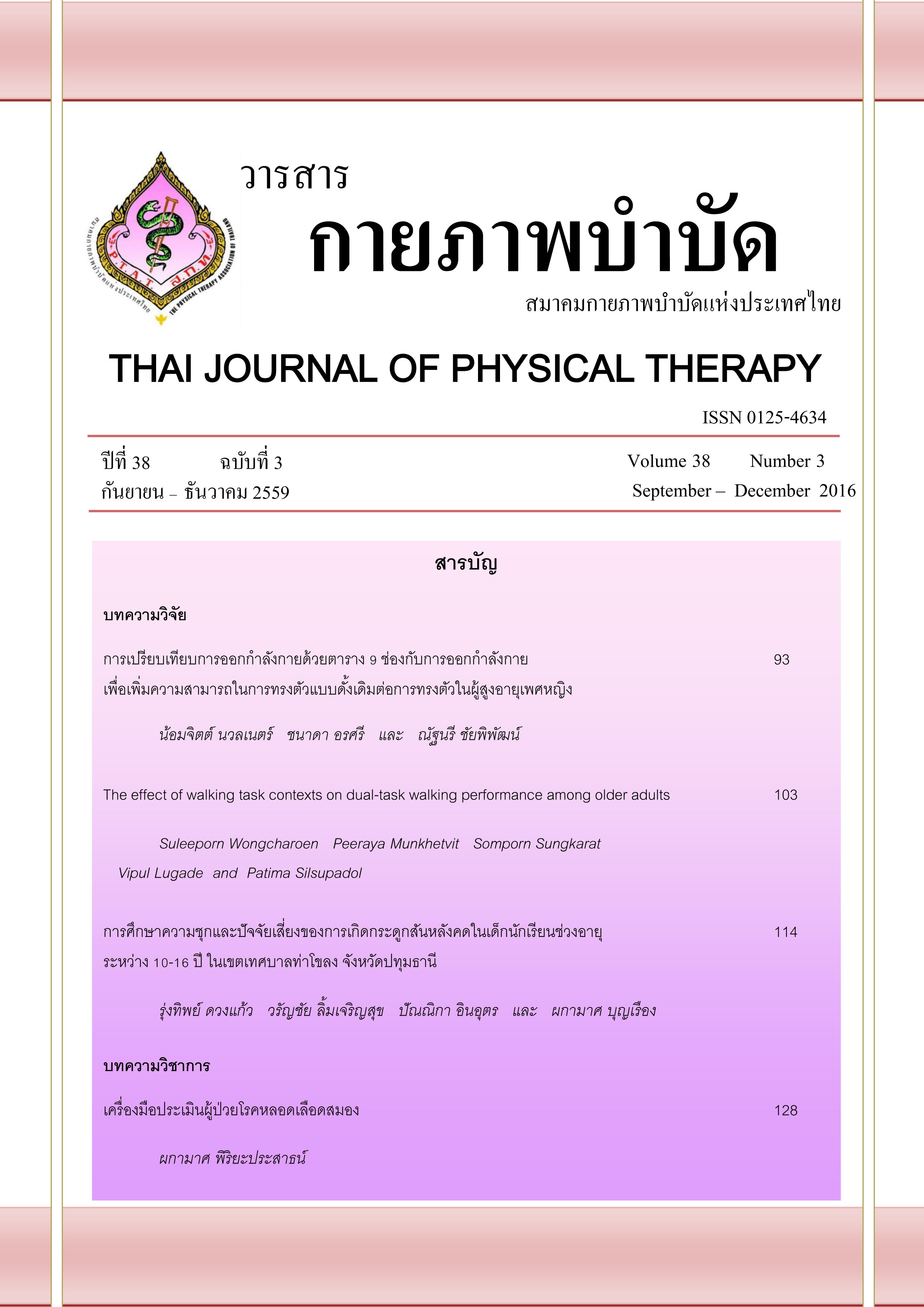ผลของบริบทการเดินต่อความสามารถในการเดินขณะทำงานอย่างอื่นร่วมด้วยในผู้สูงอายุ
Main Article Content
บทคัดย่อ
ที่มาและความสำคัญ: แม้ว่าโปรแกรมการฝึกการทรงตัวร่วมกับการฝึกการทำงานของสมองมีประสิทธิผลในการเพิ่มความสามารถในการทรงตัวของผู้สูงอายุในขณะทำงานอย่างอื่นร่วมด้วย แต่ความสามารถในการประยุกต์ใช้ทักษะที่ได้รับกับงานอื่นๆนั้นยังไม่เป็นที่ทราบแน่ชัด ซึ่งอาจเกิดเนื่องมาจากการเลือกใช้บริบทของงานที่แตกต่างกันในแต่ละการศึกษา
วัตถุประสงค์: ผลของบริบทการเดินต่อความสามารถในการเดินขณะเดินพร้อมกับทำงานอย่างอื่นร่วมด้วยในผู้สูงอายุ
วิธีการ: ผู้สูงอายุจำนวน 60 คน ได้รับการทดสอบความสามารถในการทรงตัวในขณะเดิน เป็นระยะทาง 6 เมตร ภายใต้เงื่อนไขการเดินที่แตกต่างกัน 4 เงื่อนไข ดังนี้: 1) เดินในทางปกติ 2) เดินก้าวข้ามสิ่งกีดขวาง 1 อัน 3) เดินก้าวข้ามสิ่งกีดขวาง 3 อันและ 4) เดินในทางเดินแคบ นอกจากนี้อาสาสมัครยังได้รับการทดสอบการเดินพร้อมกับทำงานอย่างอื่นร่วมด้วย ได้แก่ เดินพร้อมกับพูดชื่อสิ่งของที่อยู่ในหมวดหมู่ที่กำหนดให้ และเดินพร้อมกับนับเลขถอยหลังทีละสาม การศึกษานี้ใช้เครื่องมือวิเคราะห์การเคลื่อนไหว 3 มิติพร้อมด้วยแผ่นติดแบบสะท้อนแสงที่ติดตามตำแหน่งของร่างกายทั้งหมด 32 จุด เพื่อระบุตำแหน่งของจุดศูนย์กลางมวลของร่างกาย (Center of mass) และฐานรองรับ (Base of support)
ผลการศึกษา: ความสามารถในการเดินก้าวข้ามสิ่งกีดขวางหนึ่งอันไม่แตกต่างกันอย่างมีนัยสำคัญทางสถิติกับความสามารถในการเดินก้าวข้ามสิ่งกีดขวางสามอัน โดยประเมินจากค่า ระยะทางจากจุดศูนย์กลางมวลถึงฐานรองรับ (XcoM-BoS displacement) อย่างไรก็ตาม Xcom-BoS displacement ในขณะเดินในทางแคบนั้นสั้นกว่าการเดินก้าวข้ามสิ่งกีดขวาง
สรุปการศึกษา: การศึกษานี้บ่งชี้ว่าบริบทของการเดินส่งผลต่อความสามารถในการเดินขณะเดินพร้อมกับทำงานอย่างอื่น ดังนั้นลักษณะบริบทการเดินเป็นอีกปัจจัยหนึ่งที่ควรพิจารณาและให้ความสำคัญเมื่อทดสอบความสามารถในการเดินพร้อมกับทำงานอย่างอื่นร่วมด้วย
Article Details
เอกสารอ้างอิง
2. Herman T, Mirelman A, Giladi N, Schweiger A, Hausdorff JM. Executive control deficits as a prodrome to falls in healthy older adults: a prospective study linking thinking, walking, and falling. J Gerontol A Biol Sci Med Sci. 2010;65A:1086–92.
3. Mirelman A, Herman T, Brozgol M, et al. Executive function and falls in older adults: new findings from a five-year prospective study link fall risk to cognition. Plos One. 2012;7:1-8.
4. Silsupadol P, Shumway-Cook A, Lugade V, et al. Effects of single-task versus dual-task training on balance performance in older adults: a double-blind, randomized controlled trial. Arch Phys Med Rehabil. 2009;90:381-7.
5. Silsupadol P, Lugade V, Shumway-Cook A, et al. Training-related changes in dual-task walking performance of elderly persons with balance impairment: a double-blind, randomized controlled trial. Gait Posture. 2009;29:634-9.
6. Yamada M, Aoyama T, Hikita Y, et al. Effects of a DVD-based seated dual-task stepping exercise on the fall risk factors among community-dwelling elderly adults. Telemed J E Health. 2011;17:768-72.
7. Beurskens R, Bock O. Does the walking task matter? Influence of different walking conditions on dual-task performances in young and older persons. Hum Mov Sci. 2013;32:1456-66.
8. Beauchet O, Dubost V, Herrmann F, Rabilloud M, Gonthier G, Kressig RW. Relationship between dual-task related gait changes and intrinsic risk factors for falls among transitional frail older adults. Aging Clin Exp Res. 2005;17:270-5.
9. Berg K, Wood-Dauphinee S, Williams J. The balance scale: reliability assessment with elderly residents and patients with an acute stroke. Scand J Rehabil Med. 1995;27:27-36.
10. Powell L, Myers A. The Activities-Specific Balance Confidence (ABC) Scale. J Gerontol A Biol Sci Med Sci. 1995;50:M28-34.
11. Lezak M, Howieson D, Bigler E, Tranel D. Neuropsychological Assessment. New York, NY: Oxford University Press; 2012.
12. Chou LS, Kaufman KR, Brey RH, Draganich LF. Motion of the whole body's center of mass when stepping over obstacles of different heights. Gait Posture. 2001;13:17-26.
13. Schrager MA, Kelly VE, Price R, Ferrucci L, Shumway-Cook A. The effects of age on medio-lateral stability during normal and narrow base walking. Gait Posture. 2008;28:466-71.
14. Chou LS, Kaufman KR, Hahn ME, Brey RH. Medio-lateral motion of the center of mass during obstacle crossing distinguishes elderly individuals with imbalance. Gait Posture. 2003;18:125-33.
15. Lugade V, Lin VT, Chou LS. Center of mass and base of support interaction during gait. Gait Posture. 2011;33:406-11.
16. Hof AL. The 'extrapolated center of mass' concept suggests a simple control of balance in walking. Hum Mov Sci. 2008;27:112-25.
17. McAndrew Y, Dingwell JB. Voluntary changes in step width and step length during human walking affect dynamic margins of stability. Gait Posture. 2012;36:219-24.
18. Huxhold O, Li SC, Schmiedek F, Lindenberger U. Dual-tasking postural control: Aging and the effects of cognitive demand in conjunction with focus of attention. Brain Res Bull. 2006;69:294-305.
19. Springer S, Giladi N, Peretz C, Yogev G, Simon ES, Hausdorff JM. Dual-tasking effects on gait variability: the role of aging, falls, and executive function. Mov Disord. 2006;21:950-7.
20. Hollman JH, Kovash FM, Kubik JJ, Linbo RA. Age-related differences in spatiotemporal markers of gait stability during dual task walking. Gait Posture. 2007;26:113-9.
21. Faulkner KA, Redfern MS, Cauley JA, et al. Multitasking: association between poorer performance and a history of recurrent falls. J Am Geriatr Soc. 2007;55:570-6.
22. Hausdorff JM, Schweiger A, Herman T, Yogev-Seligmann G, Giladi N. Dual-task decrements in gait: Contributing factors among healthy older adults. J Gerontol A Biol Sci Med Sci. 2008;63:1335-43.
23. Pashler H. Dual-task interference in simple tasks: data and theory. Psychol Bul. 1994;116:220–44.


